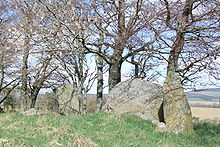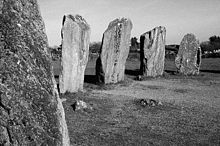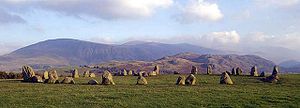- Stone circle
-
- This article is about the European Megalithic stone circles. See Stone circle (disambiguation) for other uses.
A stone circle is a monument of standing stones arranged in a circle usually alligned to the sun. The term usually refers to the stone circles created in the British Isles and the Atlantic fringe of Europe during the Late Neolithic and Early Bronze Age (estimated dates). More than 1,000 such stone circles have been cataloged by archeologists. The size and number of the stones varies from example to example, and the circle shape can be an ellipse. Stone circle monuments have also been created in some other historical places and times.
Contents
Dates and archaeology of European Megalithic stone circles
All experts agree that stone circles are of pre-Christian date, but beyond that stone circles have proven difficult to date accurately. Radiocarbon dating has produced a wide range of dates at different sites. This is at least partly due to an inadequacy of materials suitable for radiocarbon dating that can be reliably obtained from the sites. The diversity of radiocarbon evidence may also suggest that stone circles were constructed over a very long period, or were sometimes reconstructed at later dates. It is often not clear when building started.[citation needed] A further obstacle to dating is that there are generally no other archaeological artifacts associated with the stone circles. 'Traditional' archaeological artifacts, such as pottery shards, bones, etc., are not often found at the sites, and when found are frequently of a later date than the associated stone circle.
The sites display no evidence of human dwelling, and rarely encompass graves. This suggests that stone circles were constructed for ceremonies (perhaps religious ceremonies) and were in use on ceremonial occasions only. The type of ceremonies (if any) is entirely unknown. An alternative hypothesis is that they were a form of amulet or talisman, i.e., an entity acknowledging and appeasing supposed spirits dwelling in nature, meaning that their ceremonial use was secondary to their talismanic value, or equal to it. The crudeness and variety of the stones excludes the possibility that they had astronomical observation purposes of any precision. Sometimes a stone circle is found in association with a burial pit or burial chamber, but the great majority of these monuments have no such association. A stone circle is an entirely different entity from a henge, and different also from an isolated monolith, yet sometimes these other types of ancient stone monuments are found in close proximity.
The earliest known circles were apparently erected around five thousand years ago during the Neolithic period[citation needed] and may have evolved from earlier burial mounds which often covered timber or stone mortuary houses. The suggestion that they may have evolved from earlier burial mounds is undercut by the fact that, of the hundreds of Neolithic and Bronze Age circles that have been identified, none are provably centered on a burial.[citation needed] That suggests religious context, the details of which are still obscure.[citation needed]
During the Middle Neolithic (c. 3700–2500 BC)[citation needed] stone circles began to appear in coastal and lowland areas towards the north of the United Kingdom. The Langdale axe industry in the Lake District appears to have been an important early centre for circle building, perhaps because of its economic power.[citation needed] Many had closely set stones, perhaps similar to the earth banks of henges, others were made from unfounded boulders rather than standing stones.
By the later Neolithic, stone circle construction had attained a greater precision and popularity.[citation needed] Rather than being limited to coastal areas, they began to move inland and their builders grew more ambitious, producing examples of up to 400 m diameter in the case of the Outer Circle at Avebury. Most circles, however, measured around 25 m in diameter. Designs became more complex with double and triple ring designs appearing along with significant regional variation. These monuments are often classed separately as concentric stone circles.
The final phase of stone circle construction took place in the early to middle Bronze Age (c.2200–1500 BC) and saw the construction of numerous small circles which, it has been suggested, were built by individual family groups rather than the large numbers that monuments like Avebury would have required.[citation needed]
By 1500 BC stone circle construction had all but ceased.[citation needed] It is thought that changing weather patterns led people away from upland areas and that new religious thinking led to different ways of marking life and death.
Variants
Concentric stone circle
A concentric stone circle is a type of prehistoric ritual monument consisting of a circular or oval arrangement of two or more stone circles set within one another. They were in use from the late Neolithic to the end of the early Bronze Age and are found in England and Scotland.
Connected features as some sites include central mounds, outlying standing stones, avenues or circular banks on which the stones are set. Burials have been found at all excavated concentric stone circles both inhumations and urned or unurned cremations. A funerary purpose is thought likely, especially by Burl who sees the Cumbrian sites as being analogous to the kerbs that surround some chamber tombs and cobble pavements have been found in the centre of many examples. Alternatively, they may be skeuomorphs of earlier timber circle sites rebuilt in stone, especially the examples in Wessex.
Recumbent stone circle
Recumbent stone circles are a variation found throughout the British Isles and Brittany. They are a form peculiar to the north east of Scotland and south west Ireland (Drombeg stone circle near Glandore and Rosscarbery, Co. Cork). Recumbent stone circles date back to approx 3000 BC.
A recumbent circle is formed principally of a ring of stones, like all other stone circles; however, there is one, large recumbent stone laid on its side, usually flanked by the two largest of the standing stones immediately on either side. The stones are commonly graded in height with the lowest stones being diametrically opposite to the tall flankers. It is not uncommon for the circle to contain a ring cairn and cremation remains. The recumbent stone lies between the SSE and SW points of the circle. It is thought that this configuration was used for lunar observations and the changing of the seasons however such an alignment would coincide with the Winter Solstice Sunset. These circles are usually in good farmland, near hill-tops.
Distribution
Further information: List of stone circlesMegalithic monuments are found in especially great number on the European Atlantic fringe, with stone circles particularly common in the British Isles.[1]
British Isles
There are approximately 1,000 stone circles and 80 stone henges in Britain and Ireland.[2] The French archaeologist Jean-Pierre Mohen in his book Le Monde des Megalithes says: "British Isles megalithism is outstanding in the abundance of standing stones, and the variety of circular architectural complexes of which they formed a part...strikingly original, they have no equivalent elsewhere in Europe — strongly supporting the argument that the builders were independent."
Often oriented on sight lines for the rising or setting sun, it is possible that, for their builders, the cycle of seasons was very important.
The largest stone circle in Britain is at Avebury, the second largest stone circle is the Great Circle at Stanton Drew stone circles, and the Ring of Brodgar contains the third largest stone circle in Britain.
Continental Atlantic Europe
On the European continent, there are several examples in Brittany: two on the island of Er Lannic and two more suggested at Carnac. The Petit Saint Bernard circle lies further afield, in the French Alps. They are also known as harrespil in the Basque country, where villagers call them mairu-baratz or jentil-baratz that means "pagan garden (cemetery)", referring to mythologic giants of the pre-Christian era.
Post-Megalithic and Other
Further information: Stone circle (disambiguation)In Scandinavia, there was a tradition of making stone circles during the Iron Age and especially in Götaland. The appearance of these circles in northern Poland is considered to be a characteristic of the migrating Goths (see Stone Circle (Iron Age) and Wielbark Culture).
There was a separate period of stone circle building from the eighth to the twelfth century in West Africa. The best known are the Senegambian stone circles, built as funerary monuments, with more than a thousand known. Other stone circles can be found on the Adrar Plateau in Mauritania.
A stone semicircle, comprising seven 600 kilogram megaliths, has been discovered in the drowned neolithic village of Atlit Yam in the Mediterranean Sea about 1 kilometre off the shore of the Israeli city of Haifa. The stones had cupmarks carved into them and were arranged around a freshwater spring, which suggests they may have been used for a water ritual.[3]
"Megalithic" stone circles are also found in Hong Kong, see Stone Circles (Hong Kong)
Further reading
- Joanne Parker (editor), Written On Stone: The Cultural Reception of British Prehistoric Monuments (Cambridge Scholars Publishing; 2009). ISBN 1-4438-1338-9
See also
- Megalith
- Megalithic architectural elements
- List of megalithic sites
- Standing stone
- Stone row
- Cromlech
- Stone circle (Iron Age)
- Aboriginal stone arrangement
References
- ^ Aubrey Burl. "The Megalith Map". http://www.megalith.ukf.net/bigmap.htm. Retrieved 2006-09-22.
- ^ Oliphant, Margaret "The Atlas Of The Ancient World" 1992 p.81
- ^ Marchant, Jo (25 November 2009). "Deep Secrets: Atlit-Yam, Israel". New Scientist (Reed Business Information Ltd.) (2736): 40,41. ISSN 02624079. http://www.newscientist.com/article/mg20427361.400-atlityam-israel.html. Retrieved 28 November 2009.
External links
- Beagmore Stone Circles, Sperrin Mountains, Ireland
- Cairnpapple, West Lothian, Scotland
- Dark Isle - Stone Circles and Cairns of Scotland
- Drombeg Stone Circle in Ireland
- Interactive map of megalithic monuments in Europe.
- The Megalith Map
- Dolmens, Menhirs & Stone Circles in the South of France
- Stone Circles in the South of France
- Paul's Stone Circle Database
- Pretanic World - Megaliths and Monuments
- Stone circles of The Gambia
Neolithic Europe (including the Chalcolithic) ↑ Mesolithic Europe ↑ Horizons Cultures Baden culture · Beaker culture · Boian culture · Chasséen culture · Cortaillod culture · Cucuteni-Trypillian culture · Dudeşti culture · Funnelbeaker culture · Gaudo culture · Globular Amphora culture · Hamangia culture · Karanovo culture · Lengyel culture · Pitted Ware culture · Pfyn culture · Rössen culture · Seine-Oise-Marne culture · Starčevo-Kőrös-Criş culture · Tisza culture · Tiszapolgár culture · Varna culture · Vinča culture · Vučedol culture · Wartberg culture · Windmill Hill cultureMonumental architecture Bank barrow · Causewayed enclosure · Cursus · Dolmen · Henge · Megalith · Rondel · Round barrow · Statue menhir · Stone circle · Timber circle · Tor enclosureTechnology Concepts ↓ Bronze Age Europe ↓ Categories:- Bronze Age Europe
- Bronze Age sites in the United Kingdom
- Megalithic monuments
- Monument types
- Stone Age Europe
- Stone Age sites in the United Kingdom
- Stones
- Stone circles
- Sacred rocks
Wikimedia Foundation. 2010.






